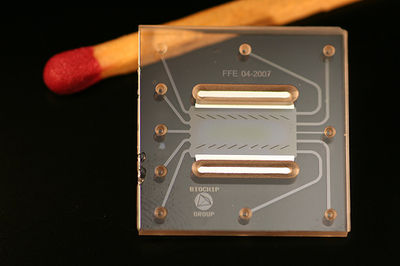Microfluidics: Difference between revisions
mNo edit summary |
No edit summary |
||
| Line 3: | Line 3: | ||
[[File:Microfluidic01.jpg|400px|thumb|right|Microfluidic Chip]] | [[File:Microfluidic01.jpg|400px|thumb|right|Microfluidic Chip]] | ||
[http://en.wikipedia.org/wiki/Microfluidics Microfluidics] refers to a set of technologies that control the flow of minute amounts of liquids or gases — typically measured in nano- and picoliters — in a miniaturized system. | |||
Just as a computer chip has carefully-arranged wires that electricity moves around, a microfluidic chip has tiny channels etched onto it that fluids move around. In a biochemistry laboratory, a chemist might pipette some solution out of a flask, mix it with a reagent, fractionate it, or perform other operations on it. The interesting thing is that most of these processes are just a matter of moving liquids around, so they can be replicated with microfluidics. The advantage is that microfluidics is much cheaper, safer and requires less skill. Room-sized diagnostic testing equipment can be shrunk down to the size of a postage stamp. This is also called "lab-on-a-chip". | |||
Applications are as vast as they are revolutionary, and include - | |||
*Medical diagnostics and blood tests | |||
*Medical and chemical research - testing for genes, [http://onlinelibrary.wiley.com/doi/10.1002/elps.201000067/abstract chemical separation] and reactions | |||
*Environmental sensing - testing water quality, air quality, monitoring for environmental toxins | |||
*Testing for plant diseases | |||
*Testing soils ([http://2010.igem.org/Team:BCCS-Bristol biosensor example here]) | |||
*[[Micromining|mining]] | |||
*developing [[:Category:Biofuels|biofuels]] | |||
*and many more. | |||
We are interested in very cheap, open-source ways of making microfluidic chips. | |||
==Materials and Equipment Used== | ==Materials and Equipment Used== | ||
| Line 22: | Line 36: | ||
*plastic lenses for cheap microscopes | *plastic lenses for cheap microscopes | ||
*[[Laser cutter]], see [http://diyhpl.us/~bryan/papers/Low-cost%20rapid%20prototyping%20of%20flexible%20microfluidic%20devices%20using%20a%20desktop%20digital%20cutter.pdf Low-cost rapid prototyping of flexible microfluidic devices using a desktop digital craft cutter] | *[[Laser cutter]], see [http://diyhpl.us/~bryan/papers/Low-cost%20rapid%20prototyping%20of%20flexible%20microfluidic%20devices%20using%20a%20desktop%20digital%20cutter.pdf Low-cost rapid prototyping of flexible microfluidic devices using a desktop digital craft cutter] | ||
==George Whitesides, Harvard University== | ==George Whitesides, Harvard University== | ||
Revision as of 00:42, 22 February 2011
Main > Food and Agriculture > Pests and weeds
Microfluidics refers to a set of technologies that control the flow of minute amounts of liquids or gases — typically measured in nano- and picoliters — in a miniaturized system.
Just as a computer chip has carefully-arranged wires that electricity moves around, a microfluidic chip has tiny channels etched onto it that fluids move around. In a biochemistry laboratory, a chemist might pipette some solution out of a flask, mix it with a reagent, fractionate it, or perform other operations on it. The interesting thing is that most of these processes are just a matter of moving liquids around, so they can be replicated with microfluidics. The advantage is that microfluidics is much cheaper, safer and requires less skill. Room-sized diagnostic testing equipment can be shrunk down to the size of a postage stamp. This is also called "lab-on-a-chip".
Applications are as vast as they are revolutionary, and include -
- Medical diagnostics and blood tests
- Medical and chemical research - testing for genes, chemical separation and reactions
- Environmental sensing - testing water quality, air quality, monitoring for environmental toxins
- Testing for plant diseases
- Testing soils (biosensor example here)
- mining
- developing biofuels
- and many more.
We are interested in very cheap, open-source ways of making microfluidic chips.
Materials and Equipment Used
Consumables:
- blotter paper
- regular paper
- wax paper, shrinky-dink
- transparency film
- cotton thread
- sewing needles
- wood sticks
- Jell-O
- beeswax?
Equipment:
- syringes
- cell phone cameras
- plastic lenses for cheap microscopes
- Laser cutter, see Low-cost rapid prototyping of flexible microfluidic devices using a desktop digital craft cutter
George Whitesides, Harvard University
In his legendary career in chemistry, George Whitesides has been a pioneer in microfabrication and nanoscale self-assembly. Now, he's fabbing a diagnostic lab on a chip.
Further Reading
- Disposable microfluidic devices created using regular wax paper
- Shrinky Dink® microfluidics - academic paper here
- Wikipedia: Microfluidics and Lab-on-a-chip
- DIY Bio
- Diagnostics For All
- Daktari
